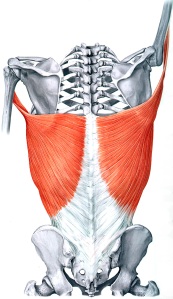Making Better Use of Your Lats
It’s another one of those often used, but tough to execute, pieces of advice, “use your lats.” I hear it a lot in the swing dance world and in the fitness world and while it seems to be a simple idea, many people struggle with it. Often, the issue is not that the lats aren’t active, but that other muscles are preventing the lats from fully activating. So here’s a quick run-down on how you can gain better access to this muscle.
 What are Lats?
What are Lats?
Just a quick definition for those of you unfamiliar with them, your lats, or latissimus dorsi, are the main power muscle involved in retracting the arm from an extended postion. So if you are is out in front or above you (flexion) and you want to pull it into back towards a neutral position by your side (extension), that’s the job of the lats. The lats are also used for a few other movements but pulling in (extending from flexion) is a primary issue in dance and athletics.
Extending to Activate
When attempting to engage their lats, most people (and most of their instructors, coaches, trainers, etc.) try to go at it directly. “Find your lats and squeeze them” can work, but most people struggle with this version. I have found that taking a more 3-dimensional, indirect approach helps many people to more effectively engage their lats, allowing them to get greater power and range of motion out of the muscle.
The basic idea is to think about expanding the muscles of the anterior (front) chest and sides (pectoralis major, pectoralis minor, and serratus anterior). Instead of focusing on your back and trying to squeeze from there, put your attention on the front of the body and allow the chest muscles to expand as you pull. Rather than initiating from the back, imagine the force starting from the chest and wrapping around and under the armpit and through to the low back. As you do this, be aware of the head and neck which have a tendency to push forward in response; keeping the head upright will help the chest to expand, enhancing the engagement of the lats.
 It also helps to work on keeping the space around the clavicles (collar bones) spacious and wide. Imagine wearing a jacket with extra wide lapels that extend into the space of the shoulders. The more the shoulders settle wide and back, the more it will help you to engage the lats when using your arms.
It also helps to work on keeping the space around the clavicles (collar bones) spacious and wide. Imagine wearing a jacket with extra wide lapels that extend into the space of the shoulders. The more the shoulders settle wide and back, the more it will help you to engage the lats when using your arms.
Why Extension Helps
The rigors of modern life (computers, driving, etc.) frequently put us in an arms forward position for extended periods of time. This means that their chest muscles are often stuck in a contracted position. As a result, many people become habituated to a posture that involves some level of collapsing in at the chest. So when they attempt something like a lat pull or retracting in from extension, the anterior chest muscles tend to stay contracted.
 This contraction of the front muscles causes an inhibitory effect in the lats. This response, known as reciprocal inhibition, causes muscles with opposing actions to be prevented from contracting at the same time. Similar to how you can only move a pulley rope by pulling on one end at a time and allowing the other end to move, a joint only moves effectively when muscles on one side expand, giving the opposing muscles room to contract. By focusing on expanding the chest, you allow room for the lats to contract and prevent the reciprocal inhibitory effect.
This contraction of the front muscles causes an inhibitory effect in the lats. This response, known as reciprocal inhibition, causes muscles with opposing actions to be prevented from contracting at the same time. Similar to how you can only move a pulley rope by pulling on one end at a time and allowing the other end to move, a joint only moves effectively when muscles on one side expand, giving the opposing muscles room to contract. By focusing on expanding the chest, you allow room for the lats to contract and prevent the reciprocal inhibitory effect.
Beyond Just Lats
This expansion tactic can be used to aid in movements throughout the body. By lengthening the antagonist muscle to a movement, you can provide more space for the acting muscle to contract, adding to both potential for power and mobility. The more you work with activating your body in a 3-dimensional fashion this way, rather than isolated muscles, the more freely you will be able to move across all your joints. So the next time you are having trouble executing a motion, try finding the opposing muscles and allowing them to expand, using space over effort to move.
